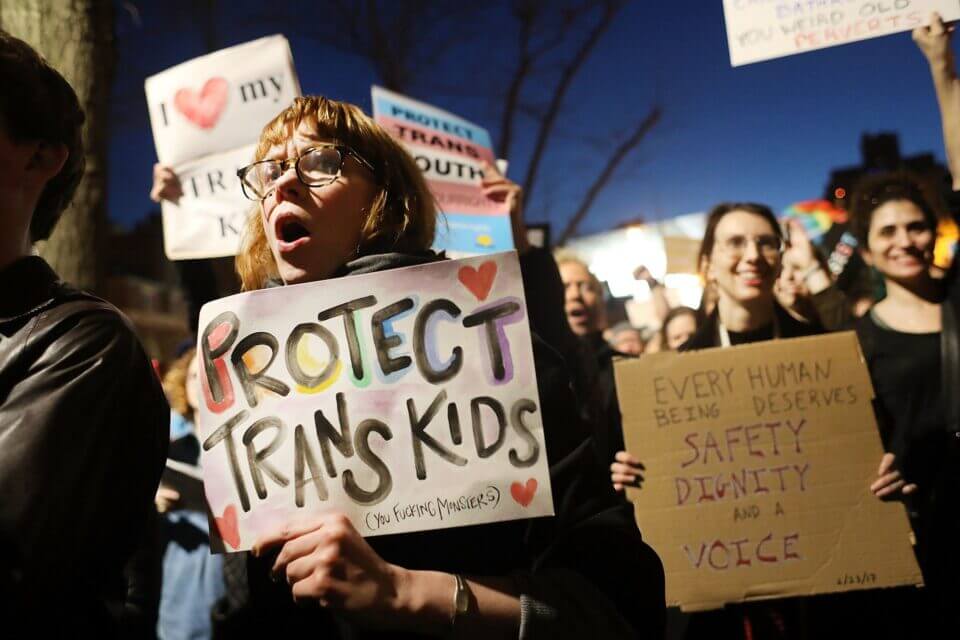
“The notion that gender identity is a matter of self-identification, separate from biological sex, not only flies in the face of science but also leads to circular reasoning.”
Only a small minority of people identify as transgender. In the United States, for example, this group accounts for about 0.6% of the adult population. Yet, in an effort to appease trans activists, there has been an overwhelming push, cloaked in the language of civil rights, to redefine even the most basic categories within our species.
According to trans activists, to assert that the categories of “man” and “woman” relate to biological realities is to invalidate transgender identities. The witch hunt against J. K. Rowling demonstrates how pervasive this idea has become. The Harry Potter author was accused of transphobia for taking issue with the phrase “people who menstruate,” quipping, “I’m sure there used to be a word for those people.” Or, take the case of Meghan Murphy, the feminist journalist who was banned from Twitter for simply pointing out that “Men aren’t women tho.” Even acknowledging that a trans woman used to be a man—or vice versa—has been deemed taboo.
What explains this phenomenon? The narrative that rampant transphobia is threatening the lives of trans people is certainly part of the explanation. Vice President-elect Kamala Harris has declared an “epidemic” of transphobic murders in the United States based on the fact that “at least 37 transgender or gender-nonconforming people [had been] killed” in 2020. This number, however, does not indicate an epidemic. In fact, it reveals that the homicide rate for trans folks is lower than in the general population. Nor is it safe to assume that all murders of trans-identified individuals are transphobic hate crimes.
Also dubious is the oft-cited statistic that 41% of adults who identify as transgender have attempted suicide at some point in their life. It, too, creates an inflated sense of urgency around the issue of transgenderism. As the sexologist and neuroscientist Dr. Debra Soh points out in her book The End of Gender, the study on which this number is based “didn’t ask respondents about comorbidity, such as other mental health conditions, nor whether they identified as transgender at the time of the suicide attempt.” She concludes: “It is possible that the suicide attempts reported by individuals in this study had nothing to do with how they felt about their gender.”
What about the recent surge in teenage girls suddenly coming out as transgender and demanding gender-affirming hormonal and surgical treatment? In her book Irreversible Damage, the journalist Abigail Shrier argues that this phenomenon has more to do with adolescent mental health and body image issues—amplified by social media and peer contagion—than with transgenderism proper. These are the same girls who would have been anorexic, bulimic, or self-harming, says Shrier; but, today, clinicians are under considerable pressure to affirm these kids’ self-image so as not to appear transphobic. This generates a feedback loop which further fuels “the transgender craze,” as Shrier calls it.
The appeal of this approach is rather obvious. It makes “because I say so” seem like a valid argument, while allowing others to feel virtuous for going along with it.
This is not to deny that gender dysphoria—severe discomfort in one’s biological sex—is a real psychological phenomenon. However, no amount of moral bullying can change the fact that self-identification does not change biological reality. Gender identity is, in fact, rooted in biology: “When sperm fertilizes an egg at conception, the baby will be either female or male,” explains Soh. “This biology will influence hormonal exposure in the womb, as well as the child’s resulting gender identity.” Rare conditions such as intersex—atypical or ambiguous sex characteristics—and gender dysphoria do not contradict this fact.
The notion that gender identity is a matter of self-identification, separate from biological sex, not only flies in the face of science but also leads to circular reasoning. What does it mean to “identify” as a woman if one’s definition of a woman is “anyone who identifies as a woman”? The appeal of this approach is rather obvious. It makes “because I say so” seem like a valid argument, while allowing others to feel virtuous for going along with it. Those who object risk social ostracization. Thus, postmodern gender theory, which insists that gender is a social construct, becomes a self-fulfilling prophecy.
Some gender theorists—such as Gender Trouble author Judith Butler—have even gone so far as to suggest that both gender and biological sex are socially (or culturally) constructed. “According to Butler,” writes Alex Byrne, professor of philosophy at Massachusetts Institute of Technology, “nature gives us something, a kind of clay that can be molded by cultural norms and power structures, but it doesn’t give us sexed bodies any more than it gives us police officers.” Not only is there no evidence for this theory; the fact that we find similar patterns across cultures as well as in other species disproves it. The theory does explain, however, why trans activists see no contradiction in denying human sexual dimorphism while championing gender-affirming medical interventions.
Trans activism, thus, pursues a dual strategy. On the one hand, it asserts that we should believe sex and gender to be social constructs; on the other hand, we are told that a large number of people are, essentially, born in the wrong body. While the latter approach echoes the “born this way” argument that has been key in promoting gay acceptance, the social constructivist approach derives from queer theory, an activist-driven, theoretical framework designed to deconstruct established categories of sex, gender, and sexuality, which are seen as inherently oppressive.
Gayle Rubin’s 1984 essay “Thinking Sex” is widely regarded as a founding text of queer theory. As Helen Pluckrose and James Lindsay point out in their book Cynical Theories, Rubin made no secret of the fact that she espoused social constructivism “not because it’s necessarily true, but because it is easier to politicize [sex, gender, and sexuality] and demand change if they are social constructs than if they are biological.” Trans activism has adopted this tactic while riding on the coattails of the gay rights movement. The latter, however, owes much of its success to the consensus that homosexuality is natural.
The feminist movement has largely embraced transgenderism. Indeed, many feminists today see transgender rights as one of the touchstones of their movement. While this has helped to alleviate Western feminism’s legitimacy crisis—legal equality between the sexes has, after all, long been achieved—it has also caused significant problems. A case in point is the demand to allow biological men who identify as female to enter women’s spaces—from public restrooms to women’s shelters to professional sports—which is clearly at odds with women’s interests.
London mayor Sadiq Khan has proclaimed: “Trans women are women. Trans men are men. Non-binary people are non-binary. All gender identities are valid.” However, merely uttering these statements does not make them true. In fact, it makes a mockery of truth. Mayor Khan’s proclamation, after all, is supported by neither logic nor evidence. This is not merely a case of politically expedient moral posturing (though it is that too). This is gaslighting. In an effort to validate trans people’s “lived experience,” self-proclaimed trans “allies” like Mayor Khan assert and promote an ideologically constructed pseudo-reality. As a result, we now live in a culture where unquestioning acceptance of transgender ideology is considered virtuous. This has impaired our ability to recognize when trans activism goes too far.
The normalization of transgenderism in young children is particularly troubling. Although most children with gender dysphoria outgrow their condition, there is immense pressure to support them in transitioning, both socially and medically. “In the event that a child can grow to be comfortable in the body they were given,” argues Soh, “it shouldn’t be controversial to contend that this would be a better outcome than a lifetime of hormones and possible surgery and sterility.” But the opposite appears to be the case. Soh writes:
“Calling into question aspects of transgender activism’s narrative—that a child who says they are transgender should be supported in transitioning; that the sudden increase in adolescent girls transitioning is due to greater social acceptance of trans people; and that no one ever regrets transitioning, and if they do, they were never really trans—gets a person called all kinds of names, but this doesn’t render the arguments untrue.”
Transgenderism lends itself to playing fast and loose with the truth, while providing a moral excuse for ideological censorship and control. It is the “entirely subjective character of the transgender identity,” writes journalist and author Mick Hume, that makes trans people “the perfect human shields behind which the reverse-Voltaires can pursue their crusade against free speech. They can decide that they are women, in a triumph of personal will over physical reality. Then they insist that they have a moral monopoly over their truth, their story—and that everybody else must accept it unquestioningly.”
Critical thinking means questioning narratives and orthodoxies. There is no reason why trans should be an exception. This is not to deny the “lived experience” of transgender individuals or to make light of transphobic discrimination. Rather, it is to draw a line between subjective feeling and objective truth (that which corresponds with reality as determined by evidence). This line should be drawn where unreasonable demands are made on society to suspend free speech and rational discourse. Trans activism aims to blur this line.
Gerfried Ambrosch is an author and writer and holds a Ph.D. in literary and cultural studies. He can be found on Twitter @g_ambrosch










